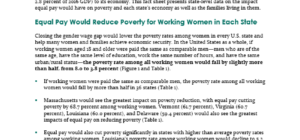

FOR IMMEDIATE RELEASE
May 11, 2017
IWPR Contact: Jennifer Clark | 202-785-5100 | clark@iwpr.org
Using new GDP data released today, analysis finds that more than half of states would see increased incomes equivalent to 3% or more of the state’s overall GDP if women had equal pay
Washington, DC—According to a statistical analysis of state data by the Institute for Women’s Policy Research (IWPR), the poverty rate for children with a working mother would be cut by at least half in 14 U.S. states if women were paid the same as comparable male workers. Overall, the analysis finds that wage increases for working women would benefit 26 million children across the United States, and nationwide, equal pay for women would reduce their families’ poverty rate by more than half. Poverty would be reduced in every state.
The impact of equal pay on child poverty is largest in Vermont, where equal pay would reduce the poverty rate of children with working mothers by three-quarters (75.6 percent). Also among the states seeing the largest impact on child poverty are Maryland (67.6 percent), Nebraska (64.4 percent), Massachusetts (64.4 percent), and Michigan (63.8 percent). In all but one state (Idaho), equal pay would reduce the poverty rate among children with working mothers by at least 30 percent.
“This analysis underscores how closing the gender wage gap is not only a women’s issue, it’s a family issue,” said IWPR Study Director Jessica Milli, Ph.D., the principal researcher on the analysis. “For policymakers who want to get serious about addressing child poverty in their state, achieving equal pay for women should be central to their efforts.”
The analysis also uses data on each state’s 2016 gross domestic product (GDP), released today by the U.S. Department of Commerce’s Bureau of Economic Analysis, to estimate the impact of equal pay on state economies. Proportionally, the wage gap cost Alabama the most of any state, with the state missing out on $8.4 billion dollars of additional wage and salary income, the equivalent of 4.1 percent of the state’s GDP in 2016.
The cumulative effect of the wage gap can have a major impact in states with larger populations. For instance, with equal pay, California’s working women would have earned $55.5 billion more dollars, an earnings increase that, by itself, is greater than the entire economy of South Dakota ($48.1 billion).
“Recent focus on the future of work for men has completely ignored the current reality of work for women. Women are now the sole or co-breadwinner in half of American families with young children, yet progress on closing the wage gap has stalled. Women, their families, and the economy are being held back by outdated policies that leave too many working women without access to good jobs, paid leave, and affordable child care. It’s time to take gender equality in labor market seriously,” said IWPR President Heidi Hartmann, Ph.D.
The Institute for Women’s Policy Research (IWPR) is a 501(c)(3) tax-exempt organization that conducts and communicates research to inspire public dialogue, shape policy, and improve the lives and opportunities of women of diverse backgrounds, circumstances, and experiences.